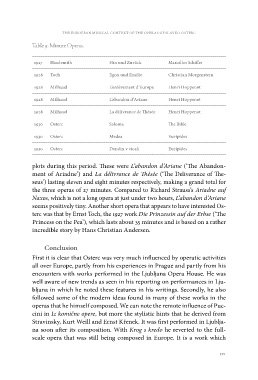Page 393 - Weiss, Jernej, ur. 2019. Vloga nacionalnih opernih gledališč v 20. in 21. stoletju - The Role of National Opera Houses in the 20th and 21st Centuries. Koper/Ljubljana: Založba Univerze na Primorskem in Festival Ljubljana. Studia musicologica Labacensia, 3
P. 393
the european musical context of the oper as of slavko osterc
Table 9: Minute Operas.
1927 Hindemith Hin und Zurück Marcellus Schiffer
1928 Toch Egon und Emilie Christian Morgenstern
1928 Milhaud L’enlèvement d’Europe Henri Hoppenot
1928 Milhaud L’abandon d’Ariane Henri Hoppenot
1928 Milhaud La délivrance de Thésée Henri Hoppenot
1930 Osterc Saloma The Bible
1930 Osterc Medea Euripides
1930 Osterc Dandin v vicah Euripides
plots during this period. These were L’abandon d’Ariane (‘The Abandon-
ment of Ariadne’) and La délivrance de Thésée (‘The Deliverance of The-
seus’) lasting eleven and eight minutes respectively, making a grand total for
the three operas of 27 minutes. Compared to Richard Strauss’s Ariadne auf
Naxos, which is not a long opera at just under two hours, L’abandon d’Ariane
seems positively tiny. Another short opera that appears to have interested Os-
terc was that by Ernst Toch, the 1927 work Die Prinzessin auf der Erbse (‘The
Princess on the Pea’), which lasts about 35 minutes and is based on a rather
incredible story by Hans Christian Andersen.
Conclusion
First it is clear that Osterc was very much influenced by operatic activities
all over Europe, partly from his experiences in Prague and partly from his
encounters with works performed in the Ljubljana Opera House. He was
well aware of new trends as seen in his reporting on performances in Lju-
bljana in which he noted these features in his writings. Secondly, he also
followed some of the modern ideas found in many of these works in the
operas that he himself composed. We can note the remote influence of Puc-
cini in Iz komične opere, but more the stylistic hints that he derived from
Stravinsky, Kurt Weill and Ernst Křenek. It was first performed in Ljublja-
na soon after its composition. With Krog s kredo he reverted to the full-
scale opera that was still being composed in Europe. It is a work which
391
Table 9: Minute Operas.
1927 Hindemith Hin und Zurück Marcellus Schiffer
1928 Toch Egon und Emilie Christian Morgenstern
1928 Milhaud L’enlèvement d’Europe Henri Hoppenot
1928 Milhaud L’abandon d’Ariane Henri Hoppenot
1928 Milhaud La délivrance de Thésée Henri Hoppenot
1930 Osterc Saloma The Bible
1930 Osterc Medea Euripides
1930 Osterc Dandin v vicah Euripides
plots during this period. These were L’abandon d’Ariane (‘The Abandon-
ment of Ariadne’) and La délivrance de Thésée (‘The Deliverance of The-
seus’) lasting eleven and eight minutes respectively, making a grand total for
the three operas of 27 minutes. Compared to Richard Strauss’s Ariadne auf
Naxos, which is not a long opera at just under two hours, L’abandon d’Ariane
seems positively tiny. Another short opera that appears to have interested Os-
terc was that by Ernst Toch, the 1927 work Die Prinzessin auf der Erbse (‘The
Princess on the Pea’), which lasts about 35 minutes and is based on a rather
incredible story by Hans Christian Andersen.
Conclusion
First it is clear that Osterc was very much influenced by operatic activities
all over Europe, partly from his experiences in Prague and partly from his
encounters with works performed in the Ljubljana Opera House. He was
well aware of new trends as seen in his reporting on performances in Lju-
bljana in which he noted these features in his writings. Secondly, he also
followed some of the modern ideas found in many of these works in the
operas that he himself composed. We can note the remote influence of Puc-
cini in Iz komične opere, but more the stylistic hints that he derived from
Stravinsky, Kurt Weill and Ernst Křenek. It was first performed in Ljublja-
na soon after its composition. With Krog s kredo he reverted to the full-
scale opera that was still being composed in Europe. It is a work which
391


